
Benalla is a small city located on the Broken River gateway to the High Country north-eastern region of Victoria, Australia, about 212 kilometres (130 mi) north east of the state capital Melbourne. At the 2021 census the population was 9,316.

The City of Banyule is a local government area in Victoria, Australia in the north-eastern suburbs of Melbourne. It was created under the Local Government Act 1989 and established in 1994 as an amalgamation of former councils. It has an area of 63 square kilometres (24.3 sq mi) and lies between 7 and 21 km from central Melbourne. In 1994 it had a population of 116,000. In June 2018 Banyule had a population of 130,237. The Yarra River runs along the City's southern border while its western border is defined by Darebin Creek.
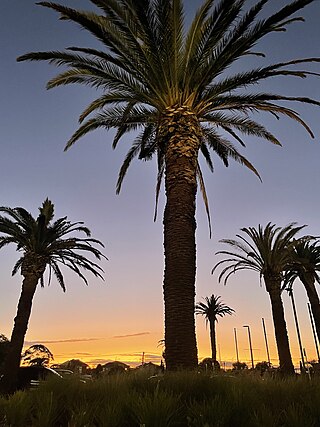
Murrumbeena is a suburb in Melbourne, Victoria, Australia, 13 km south-east of Melbourne's Central Business District, located within the City of Glen Eira local government area. Murrumbeena recorded a population of 9,996 at the 2021 census.

La Trobe Street is a major street and thoroughfare in the Melbourne central business district, Victoria, Australia. It runs roughly east–west and forms the northern boundary of the central business district. The street was laid out as an extension of the original Hoddle Grid in 1839 and was named after Charles La Trobe. La Trobe Street extends from Victoria Street in the east to Harbour Esplanade in the west.

The Geelong Botanic Gardens is a botanical garden in the city of Geelong, Victoria, Australia. The gardens are located within Eastern Park on the eastern outskirts of the central business district. They were established in 1850 and are the fourth oldest botanic garden in Australia.
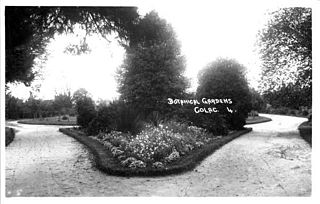
The Colac Botanic Gardens is a regional botanical garden, located at the corner of Fyans and Gellibrand streets, on the shores of Lake Colac in Colac, Victoria, Australia. Land was allocated in 1865, with the garden being established in 1868 by Daniel Bunce, and later remodelled in 1910 by Melbourne Botanical Gardens director William Guilfoyle.

Wakehurst, previously known as Wakehurst Place, is a house and botanic gardens in West Sussex, England, owned by the National Trust but used and managed by the Royal Botanic Gardens, Kew. It is near Ardingly, West Sussex in the High Weald, and comprises a late 16th-century mansion, a mainly 20th-century garden and, in a modern building, Kew's Millennium Seed Bank. Visitors are able to see the gardens, the Mansion, and also visit the seed bank. The garden today covers some 2 km2 and includes walled and water gardens, woodland and wetland conservation areas.

Eaglemont is an established suburb of Melbourne, Victoria, Australia, 10 km north-east of Melbourne's Central Business District, located within the City of Banyule local government area. Eaglemont recorded a population of 3,960 at the 2021 census.
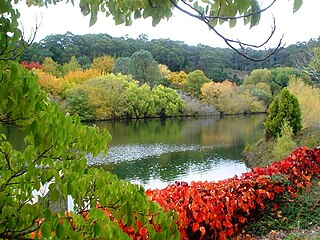
First opened in 1977, the crescent-shaped Mount Lofty Botanic Garden is situated on 100 hectares on the eastern slopes of Mount Lofty in the Adelaide Hills east of Adelaide in South Australia. The cooler, wetter location suits plants from temperate climates which are difficult to grow on the Adelaide Plains. Amongst the native Australian flora there are tree ferns, as well as exotic cultivated plants from cool climates including Rhododendron and Magnolia and the National Species Rose Collection. The Mount Lofty Botanic Garden, together with the Adelaide and Wittunga Botanic Gardens, is administered by the Botanic Gardens of South Australia, a State Government statutory authority.

The Morris Arboretum & Gardens of the University of Pennsylvania is the official arboretum of the Commonwealth of Pennsylvania. The Arboretum is open daily except for major holidays. It is located at 100 East Northwestern Avenue, Chestnut Hill, Philadelphia, Pennsylvania.

In Australia, an Avenue of Honour is a memorial avenue of trees, with each tree symbolising a person. The tradition, which originated in the Goldfields region of Victoria, Australia, is an important part of Australian culture. There are 547 known avenues of honour in Australia, in all states and territories except the Northern Territory. Over half are in Victoria.

Mount Macedon is a town 64 kilometres (40 mi) north-west of Melbourne in the Australian state of Victoria. The town is located below the mountain of the same name, which rises to 1,001 metres (3,284 ft) AHD. At the 2016 census, Mount Macedon had a population of 1,335 and is best known for its collection of 19th-century gardens and associated extravagant large homes, which is considered to be one of the most important such collections in Australia.
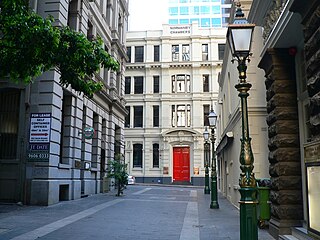
Bank Place is a street in the Melbourne central business district, Australia. It is a laneway running roughly north-south between Collins Street and Little Collins Street.
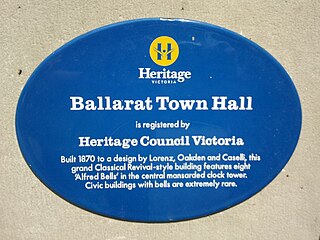
Heritage Victoria is a branch of the Victorian Department of Transport and Planning. It is the regulator responsible for administering the Heritage Act 2017. The Heritage Act provides for the protection and conservation of the cultural heritage of Victoria and establishes the Victorian Heritage Register and Heritage Inventory. The Register is a list of places and objects which are of significance to the State of Victoria. The Inventory is a list of known historical archaeological sites. Both statutory lists can be searched via the Victorian Heritage Database.

The elm cultivar Ulmus 'Purpurea', the purple-leaved elm, was listed and described as Ulmus Stricta Purpurea, the 'Upright Purpled-leaved Elm', by John Frederick Wood, F.H.S., in The Midland Florist and Suburban Horticulturist (1851), as Ulmus purpureaHort. by Wesmael (1863), and as Ulmus campestris var. purpurea, syn. Ulmus purpureaHort. by Petzold and Kirchner in Arboretum Muscaviense (1864). Koch's description followed (1872), the various descriptions appearing to tally. Henry (1913) noted that the Ulmus campestris var. purpureaPetz. & Kirchn. grown at Kew as U. montana var. purpurea was "probably of hybrid origin", Ulmus montana being used at the time both for wych elm cultivars and for some of the U. × hollandica group. His description of Kew's U. montana var. purpurea matches that of the commonly-planted 'Purpurea' of the 20th century. His discussion of it (1913) under U. campestris, however, his name for English Elm, may be the reason why 'Purpurea' is sometimes erroneously called U. procera 'Purpurea' (as in USA and Sweden.

The Field Elm cultivar Ulmus minor 'Argenteo-Variegata' or simply 'Variegata', known in Australasia and North America as Silver Elm or Tartan Elm, is said to have been cultivated in France from 1772. Green noted that variegated forms of Field Elm "arise frequently, and several clones may have been known under this name". Dumont de Courset (1802) listed an U. campestris var. glabra variegata, Loudon (1838) an U. nitens var. variegata, and Wesmael (1863) an U. campestris var. nuda microphylla variegata.
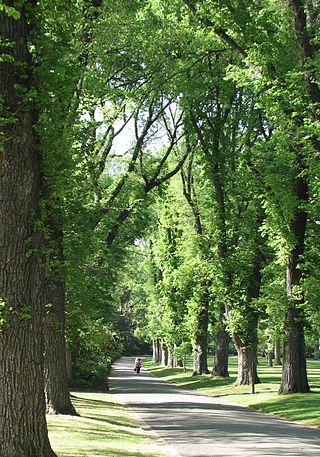
The cultivation of elms in Australia began in the first half of the 19th century, when British settlers imported species from their former homelands. Owing to the demise of elms in the northern hemisphere as a result of the Dutch elm disease pandemic, the mature trees in Australia's parks and gardens are now regarded as amongst the most significant in the world.

The National Herbarium of Victoria is one of Australia's earliest herbaria and the oldest scientific institution in Victoria. Its 1.5 million specimens of preserved plants, fungi and algae—collectively known as the State Botanical Collection of Victoria—comprise the largest herbarium collection in Australia and Oceania.

Lake Benalla, an artificial lake located in Benalla in the High Country region of Victoria, Australia, was created in the 1970s.

The field elm cultivar Ulmus minor 'Viminalis' (:'willow-like'), occasionally referred to as the twiggy field elm, was raised by Masters in 1817, and listed in 1831 as U. campestris viminalis, without description. Loudon added a general description in 1838, and the Cambridge University Herbarium acquired a leaf specimen of the tree in 1866. Moss, writing in 1912, said that the Ulmus campestris viminalis from Cambridge University Herbarium was the only elm he thought agreed with the original Plot's elm as illustrated by Dr. Plot in 1677 from specimens growing in an avenue and coppice at Hanwell near Banbury. Elwes and Henry (1913) also considered Loudon's Ulmus campestris viminalis to be Dr Plot's elm. Its 19th-century name, U. campestris var. viminalis, led the cultivar to be classified for a time as a variety of English Elm. On the Continent, 'Viminalis' was the Ulmus antarcticaHort., 'zierliche Ulme' [:'dainty elm'] of Kirchner's Arboretum Muscaviense (1864).





















